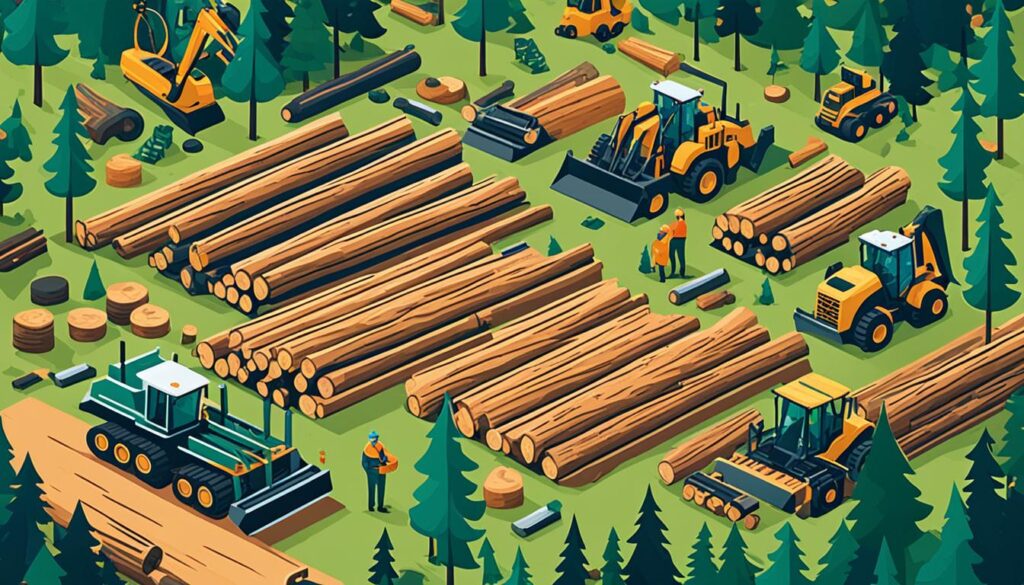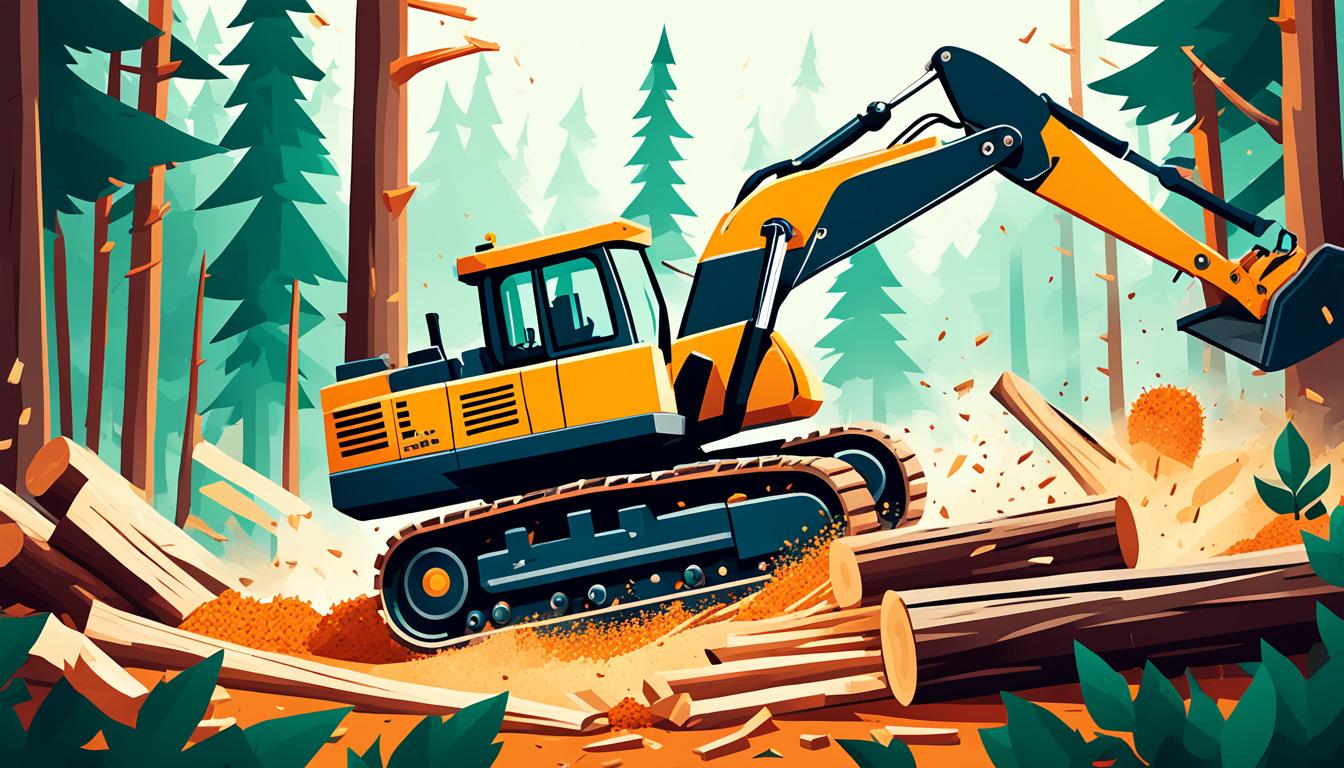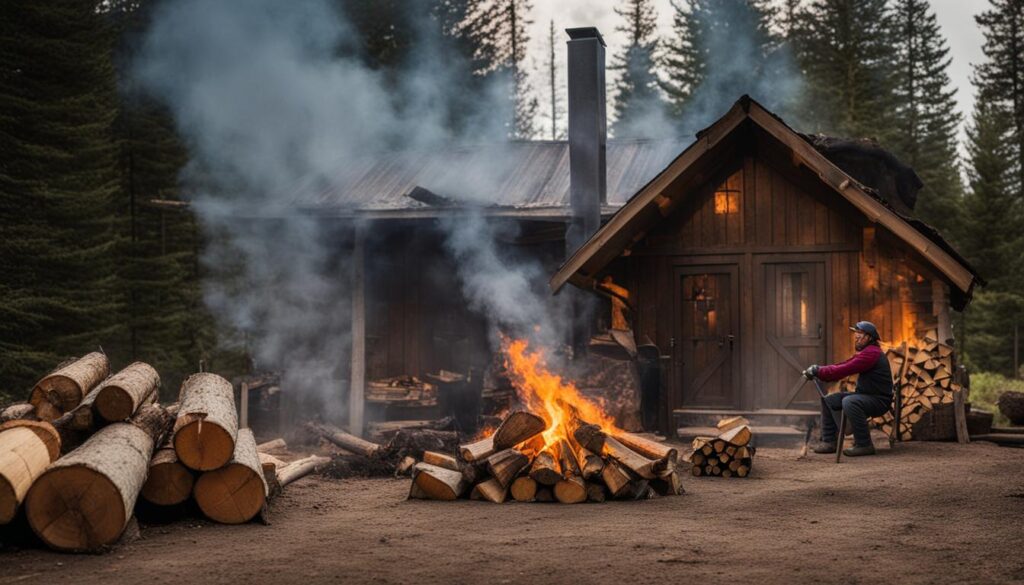Did you know that starting a logging business can cost anywhere from $10,000 to a staggering $500,000? This surprising statistic highlights the significant financial investment required to enter the logging industry. As you embark on your journey to become a successful logging entrepreneur, it’s crucial to understand the various factors that contribute to these start-up costs, such as logging equipment, contracts, regulations, safety measures, and training.
To begin your logging business, you’ll need to acquire essential forestry equipment like chainsaws, splitting wedges, axes, and maintenance tools. Depending on the scale of your operations, you may also need to invest in heavy-duty timber logging equipment such as portable sawmills or log splitters. These equipment costs can vary significantly, with estimates ranging from $500,000 for worn-out equipment suitable for private ground operations to much higher prices for brand-new machinery.
In addition to equipment expenses, securing logging contracts is a critical aspect of running a successful logging business. Government contracts, such as those with the Forest Service (FS) or the Department of Natural Resources (DNR), may have specific requirements. For example, the FS might require proof of American citizenship, a legitimate business, and literacy skills, while DNR contracts may demand a minimum of 2 years of experience and a profitable track record within the last 3 years. Furthermore, government contracts often require a 20% down payment and a bond ranging from $10,000 to $1,000,000, adding to your initial investment.
As you develop your logging business plan, it’s essential to factor in the costs associated with hiring and training employees. Wages for logging workers can range from $18 to $30+ per hour, not including additional expenses like L+I insurance, which can amount to $20 per hour per employee. Providing benefits such as health insurance and vacation time can further increase your labor costs, with estimates of $600 per month for insurance and $3 per hour for vacation time per employee. The industry norm is to have one person per piece of equipment, along with an additional 3-4 employees for bushwork associated with yarder operations.
For those considering starting as a one-man operation focused on private ground logging, the initial investment may be more manageable, ranging from $10,000 to $40,000 for equipment and other start-up expenses. This option allows you to gain valuable experience and build your reputation within the industry before expanding your operations and pursuing larger contracts.
Key Takeaways
- Starting a logging business can cost between $10,000 and $500,000, depending on the scale of operations and equipment needs.
- Essential equipment includes chainsaws, splitting wedges, axes, and maintenance tools, while heavy-duty equipment like portable sawmills and log splitters may be necessary for larger operations.
- Government contracts often have specific requirements, such as proof of citizenship, experience, and financial stability, and may require a down payment and bond.
- Labor costs, including wages, insurance, and benefits, should be factored into your logging business plan.
- Starting as a one-man operation focused on private ground logging can be a more affordable entry point, with initial investments ranging from $10,000 to $40,000.
Understanding the Logging Industry
When starting a logging business, it’s crucial to have a clear understanding of what it entails and the various factors that influence the industry. A logging business primarily involves felling trees and transporting them to sawmills or other processing facilities. As a logging business owner, you’ll work with a wide range of heavy equipment, such as chainsaws, logging trucks, tractors, and skidders, to efficiently harvest and transport timber.
What Does Having a Logging Business Mean?
Operating a logging business requires a comprehensive logging business plan that outlines your goals, target market, and strategies for success. You’ll need to consider factors such as:
- Acquiring the necessary equipment and machinery
- Hiring and training a skilled workforce
- Establishing relationships with landowners and timber suppliers
- Implementing safety protocols and best practices
- Marketing your services to potential clients
Additionally, as a logging business owner, you’ll be responsible for managing day-to-day operations, ensuring the quality of your products, and maintaining a profitable and sustainable business model.
The Role of Environmental Regulations in Logging
The logging industry is subject to numerous environmental regulations that aim to protect forests, wildlife, and ecosystems. When planning your logging operations, it’s essential to familiarize yourself with these regulations and ensure compliance. Some key considerations include:
- Obtaining necessary permits and licenses for timber harvesting
- Adhering to sustainable forestry practices and harvest limits
- Minimizing the impact of logging activities on soil, water, and wildlife
- Complying with regulations related to road construction and maintenance
Failure to comply with environmental regulations can result in fines, legal issues, and damage to your business’s reputation. As such, it’s crucial to prioritize environmental stewardship and incorporate sustainable practices into your logging operations.
Assessing Your Readiness to Start a Logging Business
Before diving into the world of starting a logging business, it’s crucial to take a step back and evaluate your readiness for the challenges that lie ahead. Running a successful logging operation requires more than just a love for the outdoors; it demands a deep passion for the work itself and a willingness to put in the hard work necessary to thrive in this industry.
Evaluating Your Passion for the Outdoors and Hard Work
Logging is not for the faint of heart. It’s a physically demanding job that requires long hours in the great outdoors, often in challenging weather conditions. Before committing to starting a logging business, ask yourself if you have the passion and drive to tackle the rigors of the job. Consider the following questions:
- Do you enjoy spending extended periods in the outdoors, even in less-than-ideal conditions?
- Are you prepared to engage in physically demanding work on a daily basis?
- Can you maintain a positive attitude and strong work ethic, even when faced with obstacles or setbacks?
If you can answer “yes” to these questions, you may have the passion and determination necessary to succeed in the logging industry.
Gaining Relevant Experience in the Logging Industry
While passion is essential, it’s equally important to gain relevant experience in the logging industry before starting your own business. Hands-on experience will give you a realistic understanding of the day-to-day operations, challenges, and opportunities within the industry. Consider the following options for gaining experience:
- Work for an established logging company to learn the ropes and gain valuable insights into the business.
- Spend a summer working in the rigging to understand the technical aspects of logging operations.
- Volunteer or work for a land clearing outfit to gain experience with various logging equipment and techniques.
By immersing yourself in the industry through logging training and hands-on experience, you’ll be better equipped to make informed decisions when starting your own logging business. This experience will also help you determine if logging is truly the right career path for you before investing significant time and resources into your venture.
Developing a Logging Business Plan
When starting a logging business, creating a comprehensive business plan is crucial for success. Your logging business plan should clearly outline your goals, target market, services offered, equipment needs, financial projections, and marketing strategies. Take into account the size and scope of your logging operations, as this will directly impact your start-up costs and the logging equipment required.
To develop an effective logging business plan, follow these steps:
- Conduct thorough research on your target market and identify potential customers, such as sawmills, furniture manufacturers, or homeowners in need of tree removal services.
- Determine the specific logging services you will offer based on your expertise, equipment, and market demand.
- Create a detailed list of the logging equipment and tools needed to carry out your logging operations efficiently and safely.
- Develop a pricing strategy that accounts for your operating costs, including equipment maintenance, insurance, and employee wages, while remaining competitive in the market.
- Prepare financial projections that estimate your revenue, expenses, and profitability over the first few years of your logging business.
- Outline your marketing strategies for attracting customers and promoting your logging services and products.
A well-crafted logging business plan will serve as a roadmap for your company, guiding your decision-making and helping you navigate the challenges of starting and growing a successful logging business. Additionally, a solid business plan is often required when seeking financing from banks, investors, or government grants, as it demonstrates your commitment and preparedness to run a viable logging operation.
Remember to review and update your logging business plan regularly as your business evolves and market conditions change. By staying adaptable and focused on your goals, you’ll be better positioned to overcome obstacles and seize opportunities in the dynamic logging industry.
Acquiring Necessary Licenses and Permits
Before you can start your logging business, it’s essential to obtain the necessary licenses and permits required by your state and local government. The process of acquiring these licenses and permits involves several steps, including researching the specific requirements for your area, registering your business structure, applying for a tax ID, and preparing various business documents.

Researching State and Local Requirements
The first step in acquiring your logging business licenses and permits is to research the specific requirements for your state and local area. These requirements can vary significantly depending on your location, so it’s crucial to contact your state’s department of natural resources or forestry agency to learn about the regulations that apply to you. Some common types of business licenses for logging operations include:
- General business licenses
- Sales tax permits
- Location and land use permits
- Zoning permits
- Building or construction permits
- Environmental licenses
In addition to these general licenses, you may also need specific permits related to timber harvesting and transportation. It’s important to research these requirements thoroughly to ensure compliance and avoid potential fines or legal issues down the road.
Obtaining Required Licenses and Permits
Once you’ve researched the necessary licenses and permits for your logging business, it’s time to start the application process. This typically involves registering your business structure with your state government, which can vary depending on whether you’re operating as a sole proprietorship, partnership, LLC, or corporation. If your business has more than one owner or employee, you’ll also need to apply for a tax ID, specifically an Employer Identification Number (EIN).
Preparing the required business documents is another crucial step in the application process. Common documents needed for permit applications include:
- Company description
- Location details
- Founding documents
- Corporate records
- Financial statements
- Insurance information
The duration and costs of acquiring your logging business licenses can vary significantly based on the type of license required. Response times can range from a few days to several months, while costs can vary from no fee to thousands of dollars. To streamline the process and ensure you have all the necessary permits, consider working with a professional service like LegalZoom that specializes in helping businesses navigate the licensing and permit requirements for their industry.
By taking the time to research and obtain the required licenses and permits for your logging business, you’ll be setting yourself up for success and ensuring compliance with all relevant regulations. This crucial step may take some time and effort, but it’s essential for establishing a strong foundation for your business and avoiding potential legal issues down the road.
Securing Financing for Your Logging Business
Starting a logging business requires a significant financial investment, with start-up costs ranging from $75,000 to several hundred thousand dollars, depending on the size and scope of your operation. Securing the necessary financing is crucial to cover expenses such as purchasing or leasing logging equipment, insurance, licenses, and permits.
Exploring Loan Options for Start-up Costs
When exploring loan options to finance your logging business, consider the following:
- The Small Business Administration’s 7(a) loan program, which offers competitive rates and terms for small businesses
- Equipment financing programs from private lenders, specifically tailored for purchasing logging equipment
- Traditional bank loans, which may require collateral and a strong credit history
Work with a financial advisor or broker to identify the best loan options for your specific needs and financial situation. They can help you navigate the application process and secure the most favorable terms for your logging business.
Applying for Grants and Seeking Investment Capital
In addition to loans, there are other financing options to consider when starting your logging business:
- Research and apply for grants from federal or state governments that support small businesses or the logging industry. These grants can help cover a portion of your start-up expenses without the need for repayment.
- Seek investment capital from friends, family, or venture capitalists who believe in your logging business plan. This option provides funding without taking on debt, but may require you to relinquish some ownership or control of your company.
Be prepared to present a comprehensive business plan and financial projections when applying for grants or seeking investment capital. Demonstrating a clear understanding of your logging costs, revenue potential, and growth strategy can increase your chances of securing the necessary financing to start your logging business.
Investing in Essential Logging Equipment
When starting a logging business, investing in the right equipment is crucial for your success. The type and amount of logging equipment you’ll need depends on the scale of your operations and the specific services you plan to offer. As you prepare to launch your logging business, carefully consider your equipment needs and budget accordingly.
Determining the Need for Heavy-Duty Timber Logging Equipment
Basic logging equipment includes chainsaws, skidders, log trucks, tractors, trailers, harnesses, and chokers. The cost of these items can range from a few hundred dollars for smaller tools like chainsaws to tens of thousands of dollars for larger machinery like skidders and log trucks. When planning your logging operations, assess whether you need heavy-duty timber logging equipment such as portable sawmills or log splitters. While these machines can significantly reduce labor time and costs, they also require a more substantial investment.
Deciding Between Buying and Leasing Logging Equipment
Another important decision when investing in logging equipment is whether to buy or lease. Leasing can be an attractive option for startups with limited capital, as it allows you to acquire the necessary equipment without a large upfront investment. However, leasing also means ongoing monthly payments and the lack of ownership of the equipment. On the other hand, buying logging equipment outright eliminates monthly payments and gives you full ownership of the machinery. When deciding between buying and leasing, consider factors such as your available capital, long-term business goals, and anticipated equipment usage.
Regardless of whether you choose to buy or lease, be sure to factor in maintenance and repair costs when budgeting for your logging equipment. Regular maintenance is essential for keeping your machinery in good working order and minimizing downtime. As you start your logging business, develop a maintenance schedule and budget for routine upkeep and unexpected repairs to keep your operations running smoothly.
Establishing Relationships with Timber Suppliers and Landowners
When starting a logging business, securing a reliable supply of timber is essential for the success of your logging operations. Establishing strong relationships with timber suppliers and landowners can provide you with consistent access to the raw materials needed to sustain your business.
Gaining Access to Woodlots and Timber Sources
One of the most effective ways to ensure a steady supply of timber for your logging business is to own your own woodlot. This grants you full control over the management and harvesting of the timber resources. However, for many new businesses, purchasing a woodlot may not be feasible due to financial constraints. In such cases, renting land from other landowners can be a practical alternative. To find woodlots available for purchase or rent, consider the following options:
- Search classifieds websites like Craigslist for listings of available woodlots in your area
- Check local newspapers and publications for advertisements related to timber land sales or rentals
- Attend local forestry events and auctions to network with landowners and learn about potential opportunities
Networking with Landowners and Scanning Classifieds for Fallen Trees
Building a network of landowners in your region can open up opportunities to harvest timber from their properties. Attend local community events, join forestry associations, and engage with landowners to establish relationships and discuss potential partnerships. When approaching landowners, be prepared to discuss your logging operations, environmental stewardship practices, and the benefits they can expect from working with your business.
In addition to networking with landowners, regularly scanning classifieds for fallen trees can provide another source of timber for your logging business. Property owners often seek assistance in removing fallen trees from their land, presenting an opportunity for you to acquire the wood while providing a valuable service. Look for listings in online classifieds, local newspapers, and community bulletin boards. When responding to these listings, emphasize your professionalism, expertise in safe tree removal, and the benefits of repurposing the fallen tree into usable lumber or firewood.
By proactively seeking out timber sources and building relationships with landowners, you can establish a robust supply chain for your logging business. Remember to prioritize open communication, transparent contracts, and sustainable logging practices to foster long-term partnerships that contribute to the growth and success of your venture in the logging industry.
Setting Up Your Logging Operations
When starting your logging business, setting up efficient and safe logging operations is crucial for long-term success. Developing a comprehensive safety plan should be your top priority, as it will help protect your crew and minimize the risk of accidents. Regular safety training, proper use of personal protective equipment, and adherence to industry safety standards are essential components of your safety plan.
To ensure smooth operations and track your business’s performance, establish a system for monitoring inventory, production, and sales. This will help you identify areas for improvement and make data-driven decisions. Additionally, create a maintenance schedule for your logging equipment to minimize downtime and extend the life of your machinery, ultimately reducing logging costs.

Building relationships with mills, wholesalers, and other buyers is crucial for ensuring a steady demand for your products. Attend industry events and reach out to potential clients to establish these connections. Finally, implement a quality control process to guarantee that your timber meets industry standards and customer expectations, helping you build a reputation for delivering high-quality products.
Here are some key steps to follow when setting up your logging operations:
- Develop a comprehensive safety plan
- Establish an inventory, production, and sales tracking system
- Create an equipment maintenance schedule
- Build relationships with buyers
- Implement a quality control process
By focusing on these essential aspects of your logging operations, you’ll be well on your way to running a successful and profitable logging business while prioritizing safety and efficiency.
Hiring and Training a Reliable Logging Crew
Building a skilled and dependable logging crew is crucial for the success and safety of your logging business. As you start your logging operation, it’s essential to identify the key roles and responsibilities within your team and recruit experienced professionals who prioritize safety and have a strong work ethic. Investing in comprehensive training and fostering a positive work environment will help ensure your crew operates efficiently and effectively.
Identifying Essential Roles and Responsibilities
When assembling your logging crew, consider the following essential roles and responsibilities:
- Fallers: Responsible for cutting down trees safely and efficiently
- Buckers: Tasked with cutting felled trees into logs of specified lengths
- Choke setters: Responsible for attaching cables or chokers to logs for transport
- Rigging slingers: In charge of setting up and maintaining the rigging system
- Equipment operators: Skilled in operating various logging machines and vehicles
Develop clear job descriptions and qualifications for each position to attract the right candidates and ensure a well-rounded, competent crew.
Recruiting Skilled and Experienced Logging Professionals
When recruiting logging professionals, look for candidates with proven experience, relevant certifications, and a commitment to safety. Consider the following strategies to attract top talent:
- Offer competitive wages and benefits packages
- Advertise job openings on industry-specific job boards and in local publications
- Network with other logging professionals and attend industry events
- Partner with vocational schools and training programs to identify promising candidates
Once you’ve assembled your crew, provide comprehensive training that covers safety protocols, equipment operation, and industry best practices. Regular safety meetings, job hazard analyses, and ongoing training will help maintain a culture of safety and productivity. Foster open communication and teamwork to create a positive and supportive work environment that encourages employee retention and job satisfaction.
Investing in your logging crew’s skills, safety, and well-being will contribute to the overall success of your logging business while minimizing costs associated with accidents, turnover, and inefficiencies. As you start your logging operation, prioritize building a strong, reliable team to ensure long-term growth and profitability.
Implementing Safety Protocols and Best Practices
When starting a logging business, prioritizing safety should be at the forefront of your operations. The logging industry is known for its high rate of accidents and injuries, making it crucial to invest in proper safety training and equipment to protect your crew and minimize potential liabilities.
To ensure a safe working environment, develop a comprehensive safety plan that includes regular safety meetings, job hazard analyses, and emergency response procedures. These measures will help identify potential risks and establish protocols to mitigate them. Invest in high-quality personal protective equipment (PPE) for your crew, such as:
- Hard hats
- Eye and ear protection
- Gloves
- Steel-toed boots
Providing your team with the necessary PPE will help safeguard them against common hazards associated with logging operations.
Prioritizing Logging Safety Training and Equipment
In addition to PPE, ensure that all equipment operators are properly trained and certified to handle the machinery they will be using. Regular maintenance and inspections of your logging equipment are essential to prevent malfunctions and accidents. Investing in safety training and well-maintained equipment not only protects your crew but also contributes to the overall efficiency and productivity of your logging business.
Adhering to Industry Standards and Regulations
To maintain compliance and promote a culture of safety within your logging business, adhere to industry standards and regulations set by organizations like the Occupational Safety and Health Administration (OSHA) and the American National Standards Institute (ANSI). Familiarize yourself with the specific guidelines and requirements relevant to your operations, and ensure that your crew is well-versed in these standards.
By implementing safety protocols and best practices, you demonstrate your commitment to the well-being of your employees and the sustainability of your logging business. Prioritizing safety not only helps prevent accidents and injuries but also enhances your reputation as a responsible and reliable logging company.
how to start logging business
Marketing your logging services and products is essential for attracting customers and growing your business. By implementing effective marketing strategies, you can showcase your expertise, build trust with potential clients, and secure valuable logging contracts.
Start by developing a professional website that highlights your logging services, experience, and commitment to sustainability and safety. Use engaging content and high-quality images to capture the attention of potential customers and demonstrate your value proposition. Optimize your website for search engines by incorporating relevant keywords related to logging operations and the services you offer.
Utilize social media platforms to connect with your target audience and share updates about your logging business. Regularly post engaging content, such as industry news, safety tips, and behind-the-scenes glimpses of your operations. Interact with followers and respond promptly to inquiries to build relationships and establish your brand as a trusted resource in the logging industry.
Attend industry trade shows and events to network with other professionals and promote your logging services. These events provide valuable opportunities to showcase your expertise, learn about the latest industry trends, and generate leads for potential logging contracts. Consider sponsoring or exhibiting at these events to increase your visibility and reach a targeted audience.
To attract new customers, consider offering promotions or discounts on your logging services. This can encourage potential clients to try your services and experience the value you provide firsthand. Be strategic in your pricing and ensure that any discounts align with your overall business goals and profitability.
Develop relationships with local businesses that may have a need for your logging products, such as:
- Construction companies
- Furniture makers
- Garden centers
- Landscaping firms
By understanding their specific requirements and offering tailored solutions, you can secure long-term contracts and establish a reliable revenue stream for your logging business.
Finally, leverage the power of word-of-mouth marketing by encouraging satisfied customers to provide testimonials and referrals. Positive reviews and recommendations from trusted sources can significantly influence potential clients’ decision-making process when choosing a logging service provider. Regularly request feedback from your clients and showcase their testimonials on your website and marketing materials to build trust and credibility in the market.
Marketing Your Logging Services and Products
Effective marketing is essential when you’re learning how to start a logging business. To attract customers and grow your operation, develop a professional website that highlights your services, experience, and dedication to sustainable and safe logging practices. Utilize social media to connect with potential clients and keep them informed about your business updates.
Networking is key in the logging industry. Attend trade shows and events to meet other professionals and promote your logging services. Consider offering special promotions or discounts to entice new customers to give your business a try. Building strong relationships with local companies like construction firms, furniture manufacturers, and garden centers can lead to valuable logging contracts, as these businesses often need the products you offer.
Word-of-mouth marketing is powerful in the logging business. Ask satisfied clients to provide testimonials and referrals to help you establish trust and credibility with potential customers. Don’t forget to explore online marketplaces and classifieds where you can advertise your logging products, such as firewood or custom-milled lumber, to expand your reach and tap into new markets for your logging operation.
FAQ
What equipment do I need to start a logging business?
How much does it cost to start a logging business?
What licenses and permits do I need for my logging business?
How can I secure a steady supply of timber for my logging business?
What safety protocols should I implement in my logging business?
How can I market my logging services and products?
Author
-

Lucas Martinez is an accomplished entrepreneur with a passion for startups. He has launched and scaled multiple businesses, providing pragmatic advice on starting and growing a business.
View all posts



